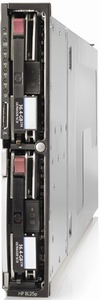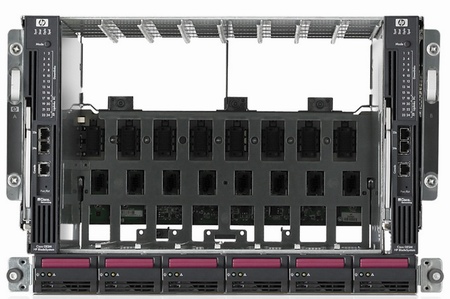Server Guide Part 1: Introduction to the Server World
by Johan De Gelas on August 17, 2006 1:45 PM EST- Posted in
- IT Computing
Blade servers: server nirvana?
The idea behind blade servers is brilliant. Imagine that you need about twelve 1U servers and you need them to be very reliable, attached to the KVM, networked and managed out of band. The result is that you have 24 power supplies, 12 KVM cables, at least 24 Ethernet cables (1 management, one network) and we are not even counting the number of cables to external storage or other devices.
What if you could put all of these 12 servers in one 6-7U chassis that has 3 (2+1) or 4 (2+2) very big power supplies instead of 24 small ones, and let them use a shared network switch, KVM switch and management module? That is exactly what a blade server is: a 6U, 7U or sometimes 10U chassis that can hold about 8 to 14 hot-swappable, vertically placed "mini-servers" called blades.
A server blade is a complete server with one or two processors and associated memory, disk storage and network controllers. Each blade within a system chassis slides into a blade bay, much like hot swappable hard disks in a storage rack. By sliding a blade into the bay, you also connect it to a shared backplane which is the link to the power supply, DVD-ROM, Ethernet and/or Fibre Channel switches, KVM switch and so on.
It doesn't take a genius to see that a blade server chassis with blades can be a more interesting option than a lot of 1U servers. The blade server should be easier to manage, offer more processing power in less space, and cost less as many components can be shared instead of being replicated in each 1U servers. Who needs 12 DVD players, 12 different remote management modules, and 24 power supplies?
According to the four biggest players in the server world - namely Intel, IBM, HP and Dell - blade servers are the way to the new enlightenment, to Server Nirvana. And there is no doubt about it, blade servers are hot: blade server sales have increased quite spectacularly, by 40% and more last year. They are certainly a very promising part of the server market... for some server applications.
The big four see the following advantages:
At the end of 2003, one year after the introduction of the blade server, IDC predicted that "the market share for blade servers will grow to 27% of all server units shipped in 2007" [2]. Currently IDC estimates are that blades account for 5 to 7% of the server market (unit shipments), so you probably can't help but wonder how IDC ever arrived at 27% in 2007. But that doesn't stop IDC from predicting again: by 2010, 25% of the server market will be conquered by blade servers. The truth is that blade servers are not always the best solution and have quite a long way to go before they can completely replace rack servers.
The idea behind blade servers is brilliant. Imagine that you need about twelve 1U servers and you need them to be very reliable, attached to the KVM, networked and managed out of band. The result is that you have 24 power supplies, 12 KVM cables, at least 24 Ethernet cables (1 management, one network) and we are not even counting the number of cables to external storage or other devices.
What if you could put all of these 12 servers in one 6-7U chassis that has 3 (2+1) or 4 (2+2) very big power supplies instead of 24 small ones, and let them use a shared network switch, KVM switch and management module? That is exactly what a blade server is: a 6U, 7U or sometimes 10U chassis that can hold about 8 to 14 hot-swappable, vertically placed "mini-servers" called blades.
A server blade is a complete server with one or two processors and associated memory, disk storage and network controllers. Each blade within a system chassis slides into a blade bay, much like hot swappable hard disks in a storage rack. By sliding a blade into the bay, you also connect it to a shared backplane which is the link to the power supply, DVD-ROM, Ethernet and/or Fibre Channel switches, KVM switch and so on.
 |  |
| Individual Blade and a Blade Chassis | |
It doesn't take a genius to see that a blade server chassis with blades can be a more interesting option than a lot of 1U servers. The blade server should be easier to manage, offer more processing power in less space, and cost less as many components can be shared instead of being replicated in each 1U servers. Who needs 12 DVD players, 12 different remote management modules, and 24 power supplies?
According to the four biggest players in the server world - namely Intel, IBM, HP and Dell - blade servers are the way to the new enlightenment, to Server Nirvana. And there is no doubt about it, blade servers are hot: blade server sales have increased quite spectacularly, by 40% and more last year. They are certainly a very promising part of the server market... for some server applications.
The big four see the following advantages:
- Reductions in cable complexity
- Operational cost savings
- Data center space savings
- Lower acquisition costs
- Improved high availability
- More efficient power usage
At the end of 2003, one year after the introduction of the blade server, IDC predicted that "the market share for blade servers will grow to 27% of all server units shipped in 2007" [2]. Currently IDC estimates are that blades account for 5 to 7% of the server market (unit shipments), so you probably can't help but wonder how IDC ever arrived at 27% in 2007. But that doesn't stop IDC from predicting again: by 2010, 25% of the server market will be conquered by blade servers. The truth is that blade servers are not always the best solution and have quite a long way to go before they can completely replace rack servers.










32 Comments
View All Comments
schmidtl - Thursday, August 17, 2006 - link
Looks good. Little history of progression on the S of RAS: disk drives were the first, and the industry sees a large proliferation of RAID configurations with hot swappable drives without any system performance degradation. High end servers have redundant/hot swappable power supplies (Dell brought that en masse to Intel servers). Recently, even CPUs have become hot swappable, something that's been around for a few years on IBM's zSeries mainframes and now pSeries servers (Power5+).stevenestes - Tuesday, March 17, 2015 - link
I posted a video talking about server basics and an in depth intro to servers, check it out if you'd like https://www.youtube.com/watch?v=v4x6ce66dug